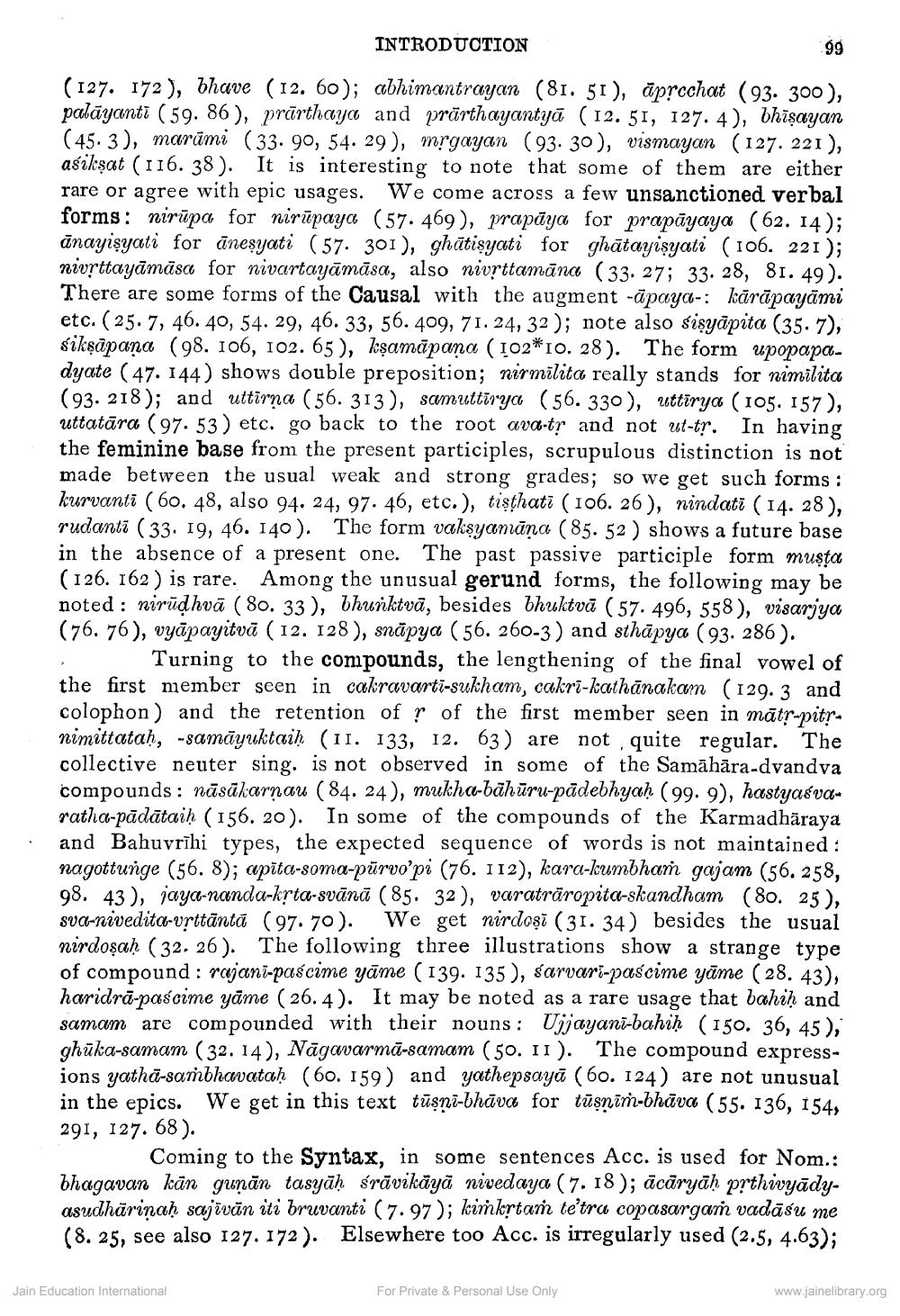________________
INTRODUCTION
(127. 172), bhave (12. 60); abhimantrayan (81. 51), āprcchat (93. 300), palāyanti ( 59. 86), prarthaya and prārthayantyā (12. 51, 127. 4), bhīşayan ( 45. 3), marūmi (33. 90, 54. 29), mrgayan (93. 30), vismayan (127. 221), asiksat (116. 38). It is interesting to note that some of them are either rare or agree with epic usages. We come across a few unsanctioned verbal forms: nirūpa for nirūpaya (57. 469), prapāya for prapāyaya (62. 14); ānayisyati for ānesyati (57. 301), ghātisyati for ghātayisyati ( 106. 221); niurttayāmāsa for nivartayāmāsa, also nivyttamāna ( 33. 27; 33. 28, 81. 49). There are some forms of the Causal with the augment -āpaya-: kārūpayāmi etc. (25. 7, 46. 40, 54. 29, 46. 33, 56.409, 71. 24, 32 ); note also sisyāpita (35.7), śikṣāpana (98. 106, 102. 65), kşamāpana ( 102*10. 28). The form upopapa. duate (17. 144) shows double preposition; nirmilita really stands for nimilita (93. 218); and uttīrna ( 56. 313), samuttīrya (56.330), uttīrya (105. 157), uttatāra ( 97.53) etc. go back to the root ava.tr and not ut-tr. In having the feminine base from the present participles, scrupulous distinction is not made between the usual weak and strong grades; so we get such forms: kurvanti (60. 48, also 94, 24, 97. 46, etc.), tişthati ( 106. 26), nindati (14. 28), rudanti ( 33. 19, 46. 140 ). The form vaksyanvāna (85. 52) shows a future base in the absence of a present one. The past passive participle form musta ( 126. 162 ) is rare. Among the unusual gerund forms, the following may be noted : nirudhva (80. 33), bhunktvā, besides bhuktvā (57.496, 558), visariya (76.76), vyāpayitvā ( 12. 128), snäpya ( 56. 260-3) and sthāpya (93. 286). . Turning to the compounds, the lengthening of the final vowel of the first member seen in cakravarti-sukham, cakri-kathānakam (129.3 and colophon) and the retention of r of the first member seen in mātr-pitr nimittataḥ, -samāyuktaiḥ (11. 133, 12. 63) are not quite regular. The collective neuter sing. is not observed in some of the Samāhāra-dvandva compounds : nāsākarnau (84. 24), mukha-bāhūru-pādebhyaḥ (99. 9), hastyasvaratha-pădātaiḥ (156. 20). In some of the compounds of the Karmadhāraya and Bahuvrihi types, the expected sequence of words is not maintained : nagottunge (56. 8); apita-soma-pürvo'pi (76. 112), kara-lumbhaṁ gajam (56.258, 98. 43), jaya-nanda-krta-svānā (85. 32), varaträropita-skandham (80.25), sva-nivedita-vrttāntā (97. 70). We get nirdoşi (31. 34) besides the usual nirdosah (32, 26). The following three illustrations show a strange type of compound : rajani-pascime yāme (139. 135), sarvari-pascime yāme ( 28. 43), haridrā-paścime yāme ( 26.4). It may be noted as a rare usage that bahiḥ and samam are compounded with their nouns: Ujjayani-bahiḥ (150. 36, 45), ghūka-samam (32. 14), Nāgavarmā-samam (50. II). The compound expressions yathā-sambhavataḥ (60. 159) and yathepsayā (60. 124) are not unusual in the epics. We get in this text tūşņābhāva for tūşnim-bhāva ( 55. 136, 154, 291, 127. 68).
Coming to the Syntax, in some sentences Acc. is used for Nom.: bhagavan kān gunān tasyāḥ śrāvikāyā nivedaya ( 7. 18); ācāryāḥ prthivyādyasudhāriņaḥ sajīvān iti bruvanti (7.97 ); kimkytań te’tra copasargam vadāsu me (8. 25, see also 127. 172). Elsewhere too Acc. is irregularly used (2.5, 4.63);
Jain Education International
For Private & Personal Use Only
www.jainelibrary.org




